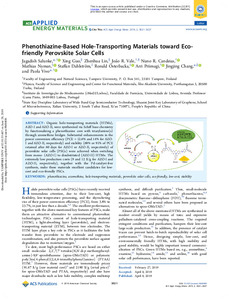Phenothiazine-Based Hole-Transporting Materials toward Eco-friendly Perovskite Solar Cells
Salunke, Jagadish; Guo, Xing; Lin, Zhenhua; R. Vale, João; R. Candeias, Nuno; Nyman, Mathias; Dahlström, Staffan; Österbacka, Ronald; Priimägi, Arri; Chang, Jingjing; Vivo, Paola (2019)
Salunke, Jagadish
Guo, Xing
Lin, Zhenhua
R. Vale, João
R. Candeias, Nuno
Nyman, Mathias
Dahlström, Staffan
Österbacka, Ronald
Priimägi, Arri
Chang, Jingjing
Vivo, Paola
2019
Julkaisun pysyvä osoite on
https://urn.fi/URN:NBN:fi:tty-201906281917
https://urn.fi/URN:NBN:fi:tty-201906281917
Kuvaus
Peer reviewed
Tiivistelmä
Organic hole-transporting materials (HTMs), AZO-I and AZO-II, were synthesized via Schiff base chemistry by functionalizing a phenothiazine core with triarylamine(s) through azomethine bridges. Substantial enhancements in the power conversion efficiency (PCE = 12.6% and 14% for AZO-I and AZO-II, respectively) and stability (68% or 91% of PCE retained after 60 days for AZO-I or AZO-II, respectively) of perovskite solar cells (PSCs) were achieved when switching from mono- (AZO-I) to disubstituted (AZO-II) HTMs. The extremely low production costs (9 and 12 $/g for AZO-I and AZO-II, respectively), together with the Pd-catalyst-free synthesis, make these materials excellent candidates for low-cost and eco-friendly PSCs.
Kokoelmat
- TUNICRIS-julkaisut [16951]
